chapter
Power Saving Mode
By Thomas Rosser
@\_subsignal
Since 2021, I have been living off-grid on the waterways of London. Living this way has been a crash course in resource management, power consumption, and system design. It has also motivated me to research low-power computing, solar power, and permacomputing,1 a concept and practice inspired by the regenerative practices of permaculture. With the need to design a low impact system that would sustain my daily needs, these ideas began to coalesce around solar energy capture, battery storage and minor tech solutions. I started exploring my relationship with abundance vs. scarcity mentalities, and took a dive into the world of solarpunk.
How to practice solarpunk? One solar punk methodology has become a bit of a rabbit hole for me… At the end of 2022, I dissected a disposable vape. At the time I observed that vaporisers were littering the streets and parks in London. Cheap, colourful and sweet flavoured nicotine vapes were booming in sales. By 2023, 5 million vapes2 were being thrown away every week in the UK alone. It became apparent that these vapes couldn’t be disposed of safely. There were no recycling points. Councils and fire departments were reporting dangerous fires caused by single use vapes that were thrown into bins. As a result of a complete lack of regulation and communication, lots of these devices were simply thrown on the floor.
Pulling apart the device, I discovered and dismantled a simple electronic circuit, consisting of a lithium-ion battery, a pressure switch, and a heating element. I reconnected the battery to a simple circuit of LEDs and voilà! I had a light-emitting-diode moment (I had not seen a “real” lightbulb in years). What else could I use these batteries for? Could I recharge the cells? As it turns out, the lithium cells in these “single-use” vapes can in fact be safely recharged countless times. They simply don’t have the means to be recharged inside the devices because they are designed to be single use.
The devices have no battery management system (or BMS), which is required to safely recharge the cells. Online research3 led me to the TP4056 chip, a versatile charging module appropriate for charging 3.7 Volt cells – a standard for low power devices. The charging module has a micro-USB input, and additional wiring pads for auxiliary power input, which I later utilised to connect to a solar panel. It also has two outputs, one for the battery and one for a direct current load. The modules have LED indicators for voltage and charge status, which makes them ideal for DIY applications.
Soon, I had a fruity smelling box full of salvaged vapes to extract power cells from. I have found many uses for this renewed source of power, and now have a box of cells ready for breadboarding low power circuits. They are particularly useful for powering small microprocessor projects, and I have had lots of satisfaction powering small networked projects using ESP-32 and Raspberry Pi Picos. Great for DIY IoT projects, wireless controllers, and small lighting projects. When hooked up to charge from a solar panel via an MPPT, they become self-sufficient low power units. At H&D Summer Camp 2023, I facilitated a workshop in which we powered a network of ESP-32 and Pico microprocessors with the cells. Set up as controllers for a multi-player instrument, each connected to various sensors and switches. We then performed collaboratively with the networked instrument on the camp radio that evening.
Taking this concept further, I developed small circuits on perfboard integrating the cells, potentiometer, switches and a small OLED display, and retrofitted them into discarded portable television handsets. I then programmed a short interactive experience onto the devices, to be used as part of a collaborative improvised performance piece called Sunspeak.
I’m interested in repurposing the cells as a radical act of resistance. For me, these cells are the spark that inspires a sense of empowerment and agency against a system of extraction. A failing system that doesn’t meet the needs of consumers or the planet. Instead it is perpetuating systems of capitalism, colonialism, the exploitation of people, and exploitation of the planet.
It is demonstrably evidenced that the extraction of lithium has significant consequences for the environment and the communities who mine the mineral. Perhaps we should question whether so-called technological development equates to progress at all, especially when the means of production for new energy storage technology relies on extractive and economic colonial practices. The energy transition is unjust, and these cells are just a drop in the ocean in comparison to the tens of kilograms of lithium required for an Electric Vehicle battery, for example. Reusing them isn’t going to save the planet or the lives of those affected by resource extraction, nor those exploited in the process. I propose that the act of renewal can be an acknowledgement of where our day-to-day electronic devices come from. A recognition of our complicity in the system that demands and produces them. An opportunity to spark a conversation that considers the possibility of an alternative future.
Drawing from and exploring the ideas of permacomputing, this practice is a process of recycling, reconnecting, and renewing parts, resources, and energy. It’s about salvaging what we already have - in this case digital detritus - and giving it new life. To draw parallels with ecological frameworks, it could be considered a kind of digital ‘recommoning’ , which is about retaining and reclaiming agency in our environments, and being able to contribute practically in response to the failures we see around us. For me, it’s about having a toolkit to experiment, challenge the status quo, and rewrite the stories that no longer serve us.
- https://permacomputing.net/
- https://www.theguardian.com/society/2023/sep/08/call-for-uk-ban-on-single-use-vapes-as-more-than-5m-discarded-each-week
- https://www.bigclive.com/
- https://hackersanddesigners.nl/communal-rebuilding-reconnecting-reusing.html
- https://www.greenmatch.co.uk/blog/is-lithium-mining-bad-for-the-environment
- Recommoning (by Nadia Shaikh) in Wild Service: Why Nature Needs You. 2023. Bloomsbury
How to repurpose a vape battery:
You will need:
- Salvaged disposable vape
- Pliers
- Soldering iron & solder
- Wire cutters
- Red & Black Wire (or pre-cut JST connectors)
- TP4056 Charging Module
- hot glue gun
- Solar panel and MPPT module (to recharge using solar power)
- heat shrink wrap (if you’re feeling extra)
1) First, using a pair of pliers, pull out the mouthpiece of the vape. It’s a good idea to wipe this with some antibacterial fluid first, for hygiene sake - especially if it’s a found device.

2) Carefully cut the wires between the battery and the rest of the circuit, being careful not to short circuit the battery cell. There will be three wires. Red for positive, black for negative, and a third colour (usually blue) which connects to the pressure switch.

3) If needed, desolder any remaining wires from pads on the battery cell terminals.
4) Solder new wires to the corresponding terminals of the cell. I have been using JST connectors to keep things organised and modular.

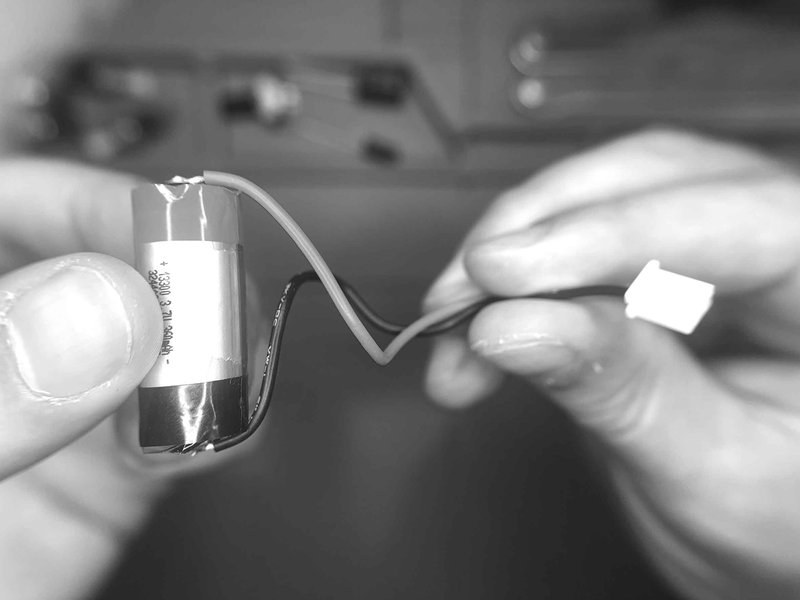
5) Using a hot glue gun, pop a blob of glue over the soldered battery connections to insulate and secure the terminals.
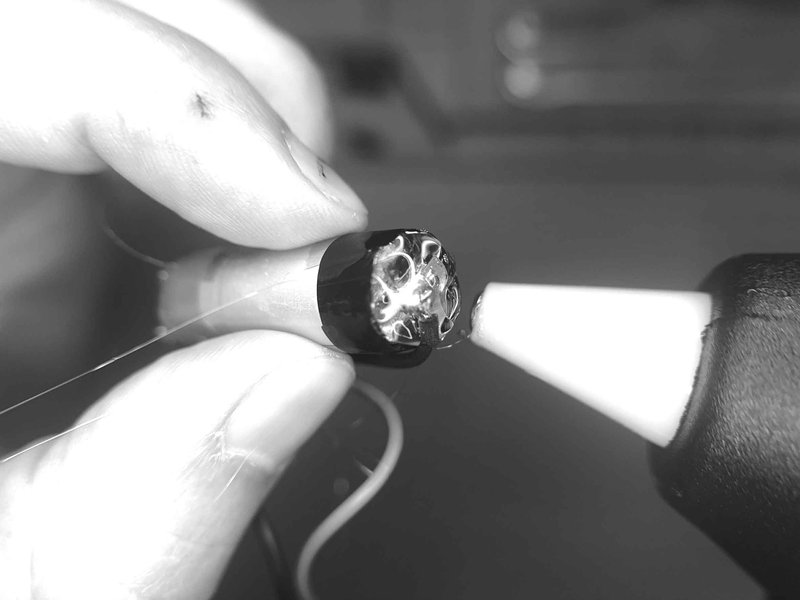
6) Solder the cables to the Batter (B+ and B-) outputs on the TP4056 module. Be sure to match the correct polarity.
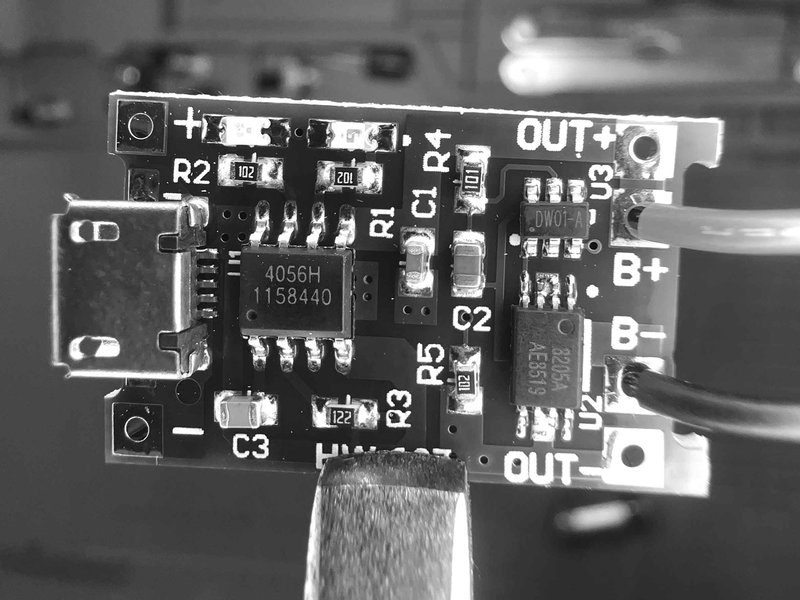
7) You can now recharge the cell using a micro-USB cable!

8) To make full use of the charging module, solder a set of wires to the TP4056 input pads either side of the micro-USB port. You can also connect a set of wires to the OUT + and - in order to power a load directly through the module.
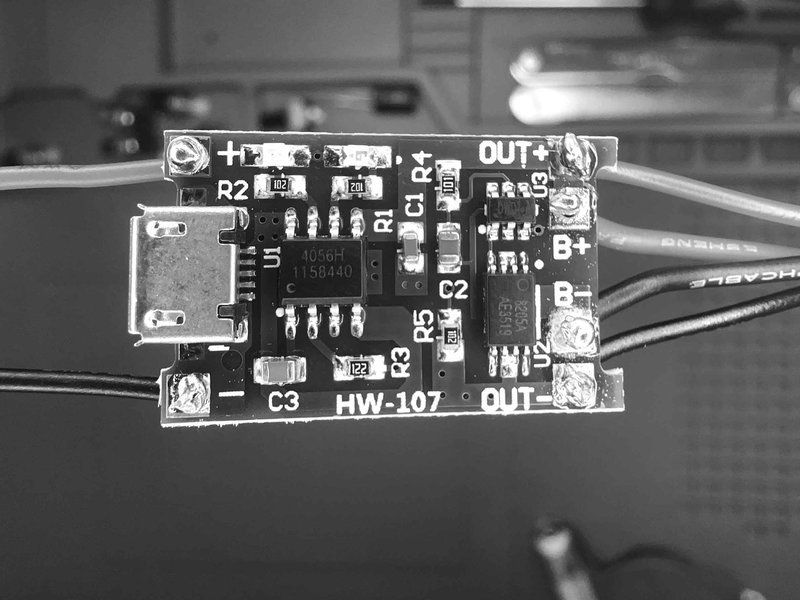
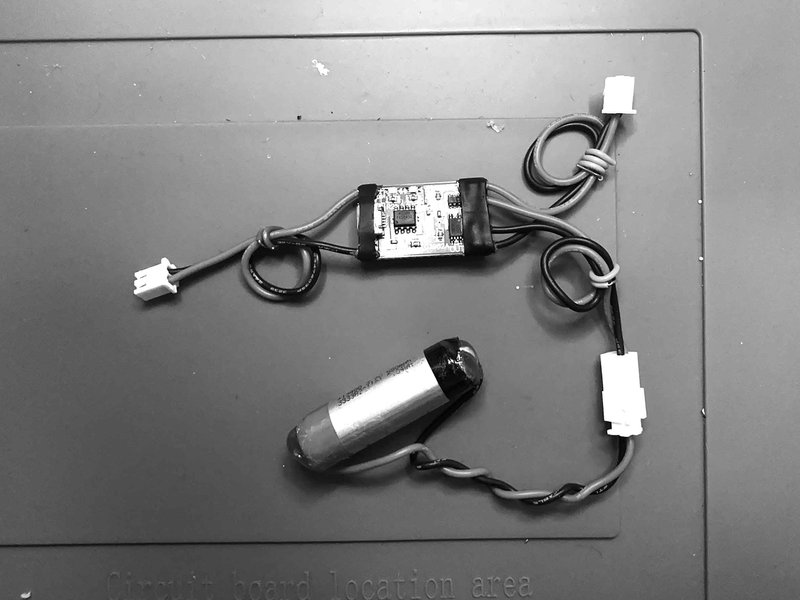
9) Using the JST connections, connect the charging module to an MPPT, and then to a small solar panel, in order to charge these via the sun.
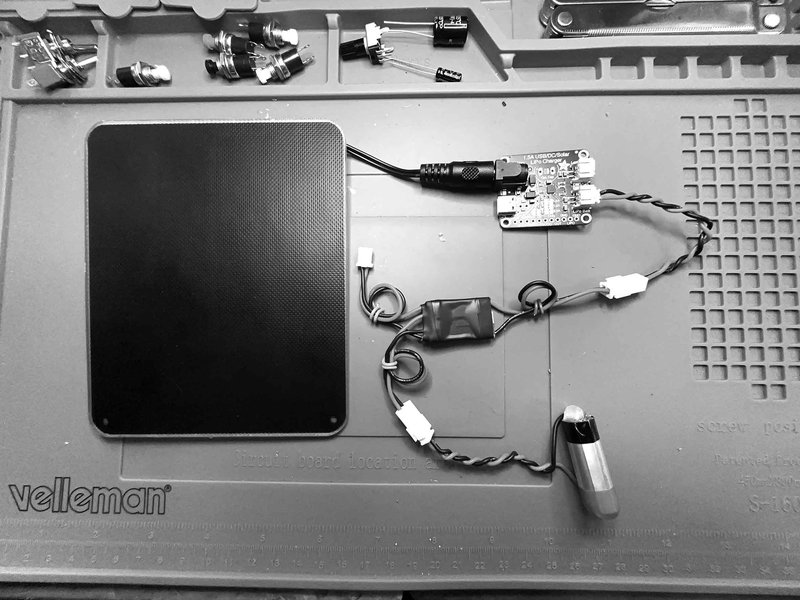
Notes:
- Be careful not to short circuit the battery cell when handling, as it doesn't have any current protection.
- I use pairs of JST connectors to make things easier. When using a pair of socket-terminal connectors for the battery charging pads and battery terminal wires, they can only connect one way. This means I never get the polarities the wrong way round when connecting to a circuit.
- The TP4056 module doesn't allow simultaneous charging and discharging of the cell. You'll have to charge it via the module first, then plug it into a circuit to use.